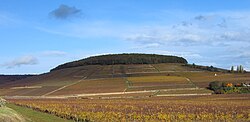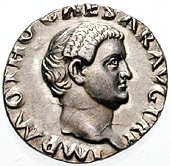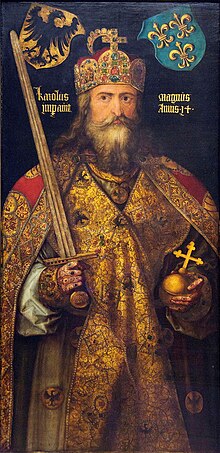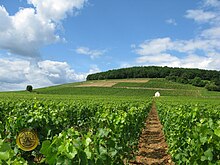Corton-Charlemagne

Corton-Charlemagne is an
Corton-Charlemagne is named after the Holy Roman Emperor Charlemagne, who once owned the hill of Corton on which the vineyards now rest. The first mention of a Clos de Charlemagne dates to 1375, in a lease of the 'Clos le Charlemagne' by the Chapitre de Saint-Androche-de- Saulieu.[3] According to later legend, the vineyards are dedicated to white grape varieties because the emperor's wife preferred white wines as they did not stain his beard.[4] The AOC was created in 1937.[5]
The vines are located on the higher ground of a hilltop that stretches between the
As of 2012, the Corton-Charlemagne AOC was producing an average of 2,280 hectoliters of wine a year (around 304,000 bottles of wine) representing more than 2 out of every 3 bottles of all the Grand Cru class white wine produced throughout the Côte de Nuits and Côte de Beaune.[8] Bonneau du Martray is the largest single owner of vines within the Corton-Charlemagne vineyard with 9.5 hectares.[9]
History and name

The hill of Corton that contains the Corton-Charlemagne AOC is located behind (north/northwest) the commune of Aloxe-Corton. The commune itself has had a long history dating to its time as a 3rd-century AD
Vineyards were recorded on the hill by 696 AD though it very likely that they were planted much earlier.

According to legend, Charlemagne noted to the Abbey sections of the slope where the snow melted first and ordered that grapevines be planted on that slope. His orders were followed and the hill of Corton was planted first entirely with red grape varieties. Some time later, Charlemagne's fourth wife, Luitgard, was said to be displeased with red wine drippings on the white beard of the king and ordered that a section of the hill be pulled up and replanted with white grape varieties—a section that is today known as Corton-Charlemagne.[5][11]
Though written records have noted acclaim for the white wine from the region as early as the 8th century, the early 19th century wine writer André Jullien made no mention of any white wine being made in Corton in his 1816 catalog of wine regions Topographie de tous les vignobles connus. However, Chardonnay is believed to be the "pinot blanc" mentioned by Dr. Jules Lavalle in his 1855 work on the terroir of the Côte d'Or, Histoire et Statistique de la Vigne de Grands Vins de la Côte-d'Or. In this work Lavalle noted that Pinot noir was planted on the middle slopes and lower ground of the Corton hill while "pinot blanc" was found on the higher slopes—an arrangement that is roughly the same as the vineyard plantings on the hill today.[5]
Geography and lieu-dits
At the very top of the hill of Corton are the densely covered woodland known as the Bois de Corton. On the slopes just below the woodland, most of the clay topsoil has eroded away leaving a narrow band of
Further down the slope, the
The lieu-dits responsible for the majority of Corton-Charlemagne are Le Charlemagne, Les Pouget and Les Languettes.[10]
Climate and viticulture

As part of the Burgundy wine region, the hill of Corton shares the same
As Chardonnay
Beyond spring frost, the other viticulture hazard that growers have to worry about is
The Chardonnay vine has a tendency to produce excessive foliage which can hamper the ripening process with the vine diverting more energy to its leaves than to producing
Wine grapes

Today the only permitted grape in Corton-Charlemagne is Chardonnay. However, its presence on the hill is a relatively recent occurrence. Until the end of the 19th century,
In Corton-Charlemagne, Chardonnay is valued for its ability to adapt to a variety of soils and
AOC regulations and production figures

Wines
In 1998, the combined Corton-Charlemagne and Charlemagne grand cru contained 51 hectares (130 acres) that produced 2325 hectoliters of Grand Cru white wine.[5] By 2008, those figured changed only slightly with 52.44 hectares (129.6 acres) of vineyard surface being in production within the AOC producing 2,237 hectoliter of wine, corresponding to just under 300,000 bottles.[6]
Charlemagne AOC and Corton blanc
Out of the three Grand Cru AOCs that make up the hill of Corton, the Charlemagne AOC is the least used of these, as the majority of growers have elected to use the Corton-Charlemagne AOC for white wines from vineyards that are entitled to both appellations.[13] In 2008, only 0.28 hectares (0.69 acres) of the En Charlemagne vineyard surface was in production for Charlemagne AOC, producing a total of 7 hectoliters (essentially three barrels worth of wine).[6]
Similarly, white wines made from lieu-dits primarily used for Corton AOC (approximately 2 hectares (4.9 acres) of Chardonnay producing around 88 hectoliters of wine) can be labeled as Corton-Charlemagne or as Corton blanc.[5]
Wine

Master of Wine
Wine writer Tom Stevenson describes Corton-Charlemagne as "the most sumptuous of all white Burgundies" with rich buttery and fruit flavors and notes of cinnamon, vanilla and honey.[8]
Growers and producers
Like most
Among the owners of a 16 hectare section of Corton-Charlemagne that falls within the boundaries of the Aloxe is Hospices de Beaune and Maison Louis Latour while Bonneau du Martray owns a large part of the 19 hectare section along the Pernand-Vergelesses section with Domaine Comte Senard also having significant holdings.[5]
References
- ^ Journal Officiel de la République Française (25 October 2011). "Cahier des charges de l'appellation d'origine contrôlée "Corton-Charlemagne""(PDF) (in French). Retrieved 26 March 2013.
- ISBN 0-7513-0793-9.
- S2CID 95243588.
- ISBN 1-84533-036-6.
- ^ ISBN 0520220935.
- ^ a b c BIVB: Les Appellations d’Origine Contrôlée de Bourgogne, accessed on November 3, 2009
- ^ ISBN 978-1402778827.
- ^ ISBN 9780756686840.
- ISBN 1-84000-704-4.
- ^ ISBN 9780198609902.
- ^ Schamberg, Anne (1 March 2013). "A lesson on Burgundy wine is simpler than it sounds". Milwaukee Journal-Sentinel.
- ISBN 1-55297-720-X.
- ^ "Corton-Charlemagne, appellation Bourgogne". vins-bourgogne.fr. 2013. Retrieved 26 March 2013.[permanent dead link]
